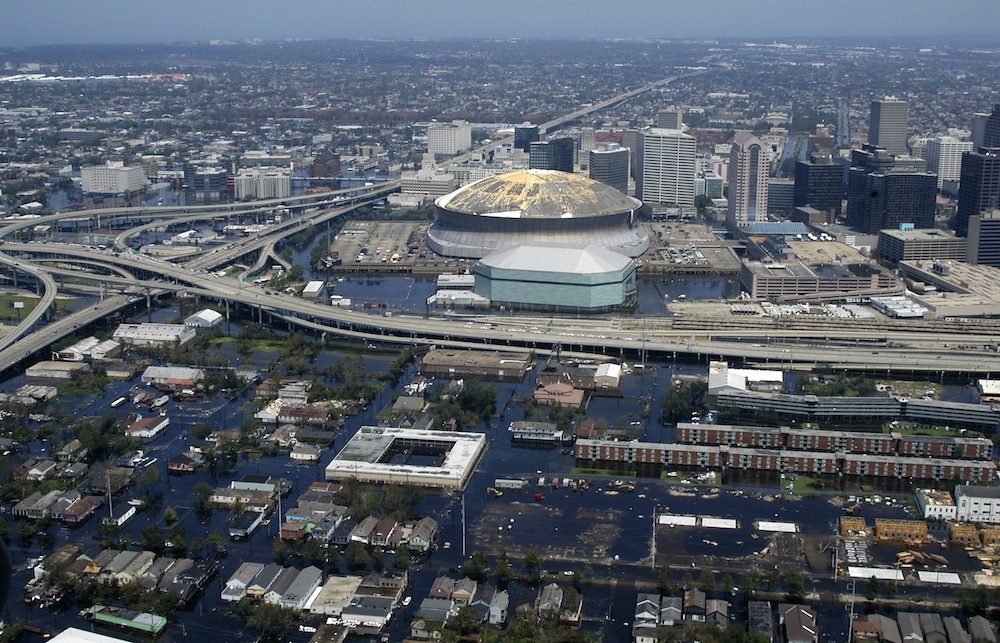INSTITUTE INDEX: New Orleans' recovery seven years after Katrina

Number of breaches that occurred in New Orleans' federally built levee system following Hurricane Katrina, which struck the U.S. Gulf Coast seven years ago today: 53
Percent of the city flooded as a result: 80
Total number of U.S. deaths directly related to Katrina: about 1,500
Number of those deaths that were in Louisiana: 1,300
Number of deaths in New Orleans: 771
Rank of the Lower 9th Ward, a predominantly African-American community, among the New Orleans neighborhoods with the greatest number of deaths: 1
Of the deaths in New Orleans, number due to direct exposure to the flooding: 518
Estimated economic damage the disaster caused in Orleans Parish alone: $14 billion
Amount being spent to rebuild the levee system protecting New Orleans, with that work almost completed: $14.5 billion
Inches of rain in a 24-hour period that can be handled by New Orleans' current stormwater management system: 4.2
Inches of rain expected from Hurricane Isaac: 20
Date on which government whistleblower Maria Garzino wrote to President Obama detailing how the Corps knowingly installed inadequate stormwater pumping equipment in New Orleans after Katrina: 2/2011
Value of improvements currently planned for the city's stormwater system: $2 billion
Acres of Louisiana coastal wetlands destroyed by the Mississippi River Gulf Outlet, a 76-mile-long canal built by the Army Corps of Engineers in the 1960s as a shipping shortcut between New Orleans and the Gulf of Mexico: 27,000
Percent by which MRGO intensified Katrina's initial storm surge into New Orleans, which is about 50 miles east of where the storm's center came ashore in Mississippi: 20
Year in which the Corps closed MRGO following sustained public outcry: 2009
Number of years that the MRGO Restoration Plan, which would rebuild destroyed wetlands, is now overdue because of a conflict between federal and state officials over the scope of the plan and who should finance it: 4
Percent of New Orleans' population lost since Katrina: 26
Percent of New Orleans' population that was African-American before Katrina: 67
After Katrina: 60
Rank of New Orleans among the fastest-growing large cities in the U.S. between 2010 and 2011: 1
In 2004, percent of New Orleans renters paying more than 30 percent of their pre-tax income on rent and utilities, a level considered unaffordable: 51
That figure today: 60
Rank of New Orleans among U.S. cities with the highest rates of homelessness: 2
For income inequality among U.S. cities with more than 10,000 residents: 2
Percent change in New Orleans' poverty rate from 1999 to 2010: 0
Percent of the city's population that lives in poverty today: 27
Percent of the city's children who currently live in poverty: 42
Percentage of New Orleans' public school students who attended schools that met state standards during the 2003-04 academic year: 28
Percentage points by which that number had increased by the 2010-11 school year: 40
Rank of New Orleans among U.S. cities for percentage of public school students who are enrolled in charter schools: 1
Percent of the city's students who attend charters, which were heavily promoted in the aftermath of the Katrina disaster: 75
Year in which parents of children with special needs and advocates including the Southern Poverty Law Center filed an ongoing federal lawsuit alleging that charter schools in New Orleans were refusing to enroll disabled students, kicked them out, or neglected to provide needed services: 2010
Number of weeks after Katrina hit New Orleans that then-Gov. Kathleen Blanco announced that state-owned Charity Hospital, which served New Orleans' poor, would close permanently, even though the military had prepared it for reopening: 3
Number of months after that when construction finally got underway on the University Medical Center, Charity's replacement: 83
Number of families that were displaced by the hospital's construction: 70
Year in which the new hospital is slated to open: 2014
As of August 2012, about that the Federal Emergency Management Agency had set aside for debris removal and infrastructure repairs for the New Orleans metro area: $9.7 billion
Amount of that money still forthcoming: $3.8 billion
(Click on figure to go to source. U.S. Navy photo of Hurricane Katrina's floodwaters in New Orleans by Photographer's Mate Airman Jeremy L. Grisham.)
Tags
Sue Sturgis
Sue is the former editorial director of Facing South and the Institute for Southern Studies.
